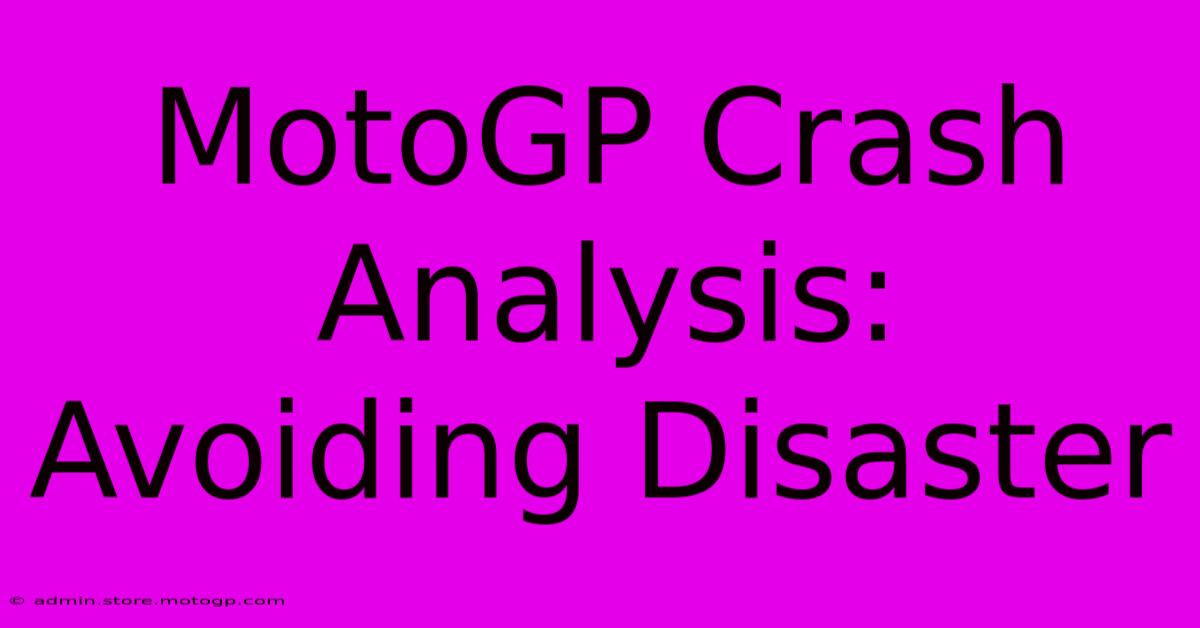MotoGP Crash Analysis: Avoiding Disaster

Table of Contents
MotoGP Crash Analysis: Avoiding Disaster
Motorcycle racing, especially at the elite MotoGP level, is a breathtaking spectacle of speed, skill, and precision. However, the inherent risks are undeniable. High speeds, aggressive overtaking maneuvers, and unforgiving tracks mean crashes are an unfortunate reality. Understanding the causes of these crashes is crucial, not only for improving rider safety but also for enhancing performance. This article delves into the common causes of MotoGP crashes and explores strategies for mitigation.
Understanding the Dynamics of MotoGP Crashes
MotoGP crashes are rarely simple events; they're usually the culmination of multiple factors. Analyzing these factors is key to preventing future incidents. Let's break down some of the most significant contributing elements:
1. Rider Error:
This is arguably the most common cause. Rider error encompasses a wide range of mistakes, including:
- Incorrect line selection: Choosing the wrong racing line can lead to loss of control, especially in high-speed corners or during overtaking attempts.
- Poor braking: Over-braking or braking too late can lock up the wheels, leading to a loss of traction and a subsequent crash. Conversely, under-braking can result in running wide into corners or other hazards.
- Excessive lean angle: Pushing the bike beyond its limits in a corner can lead to a high-side or low-side crash.
- Loss of concentration: Even a momentary lapse in concentration can have catastrophic consequences at these speeds.
- Incorrect throttle application: Sudden or inappropriate throttle input can cause the rear wheel to spin, leading to a loss of control.
2. Mechanical Failures:
While less frequent, mechanical failures can also cause devastating crashes. These can include:
- Tire failures: Punctures, tire degradation, or unexpected tire blowouts can result in immediate loss of control.
- Brake failure: A loss of braking power can render a rider helpless in a corner or during a high-speed straight.
- Engine failure: While rare, engine failure can lead to a sudden loss of power, potentially causing the rider to lose control.
- Suspension issues: A malfunctioning suspension system can drastically impact the bike's stability and handling.
3. Track Conditions:
The condition of the track plays a significant role. Factors such as:
- Oil spills: Oil on the track significantly reduces grip, increasing the risk of crashes.
- Wet track: Rain dramatically reduces traction, demanding more cautious riding techniques.
- Gravel traps: While designed for safety, improperly maintained or poorly designed gravel traps can sometimes exacerbate crashes.
- Track debris: Debris from previous crashes or other sources can also compromise tire grip and lead to accidents.
Strategies for Avoiding MotoGP Crashes
Minimizing the risk of crashes involves a multifaceted approach:
1. Rider Training and Skill Development:
Continuous training is paramount. This includes:
- Advanced riding techniques: Mastering advanced braking, cornering, and overtaking techniques is vital.
- Physical fitness: Maintaining peak physical condition is crucial for managing the physical demands of MotoGP racing.
- Mental preparedness: Developing strong mental focus and resilience helps riders cope with the pressure and demands of racing.
2. Technological Advancements:
Technological innovations play a crucial role in safety:
- Improved tire technology: Advances in tire construction and compounds enhance grip and durability.
- Advanced braking systems: Modern braking systems offer improved control and responsiveness.
- Sophisticated data analysis: Collecting and analyzing rider data provides insights into performance and helps identify potential risks.
- Improved safety features: Improvements in safety gear and track design contribute to reducing the severity of crashes.
3. Track Maintenance and Safety Procedures:
Effective track management minimizes risks:
- Regular track inspections: Routine inspections help identify and address potential hazards.
- Swift response to incidents: Efficient procedures for cleaning up oil spills and removing debris are essential.
- Improved safety barriers: Strategically placed and robust safety barriers mitigate the impact of crashes.
Conclusion: A Continuous Pursuit of Safety
MotoGP crashes are complex events. A combination of rider skill, technological advancements, and track maintenance contributes to both their occurrence and prevention. By focusing on rider training, technological improvements, and track safety, the sport can continuously strive towards a safer and more exciting future. The pursuit of safety is an ongoing process, requiring constant vigilance and innovation to reduce the risk of these dramatic and sometimes tragic events.

Thank you for visiting our website wich cover about MotoGP Crash Analysis: Avoiding Disaster. We hope the information provided has been useful to you. Feel free to contact us if you have any questions or need further assistance. See you next time and dont miss to bookmark.
Featured Posts
-
Explore The Untamed Beauty Of The Queen Circuit
Feb 20, 2025
-
Cota Parking Easy In Easy Out With Your Pre Paid Pass
Feb 20, 2025
-
The Aftermath Accident Moto Gps Impact On The Championship
Feb 20, 2025
-
Moto Gps Most Dramatic Crashes Pictures That Shock
Feb 20, 2025
-
The Science Behind Winning Sting F1
Feb 20, 2025
